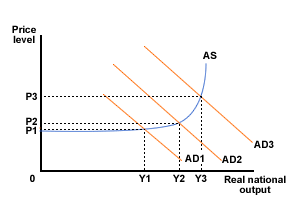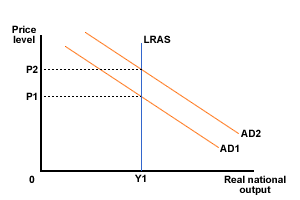Types and causes of inflation:
Just as with unemployment the words type and cause
are synonimous and can be used interchangeably. You can separate out 3
types (causes) of inflation but really there are only 2 causes and this
can be reduced to 1 cause. Confused?OK, what causes prices to rise? Yes excess demand so a persistant situation of excess demand will cause a persistent increase in prices (inflation). So there is only 1 cause of inflation - persistent excess demand.
However, excess demand can be caused either by an increase (shift to right) in Aggregate Demand or a decrease in Aggregate Supply. So there are 2 causes of excess demand so there are 2 causes of inflation: Demand Pull and Cost Push (details of Demand Pull and Money Supply are below and Cost Push on Page 98).
However, a special case of demand pull is when this is caused by increases in the Money Supply - `Too much money chasing too few goods´. Therfore there are said to be 3 causes (Types) of inflation:
- Cost Push
- Demand Pull
- Increases in the Money Supply
Syllabus: Explain, using a diagram, that demand-pull inflation is caused by changes in the determinants of AD, resulting in an increase in AD.
Demand-pull inflation
 Demand-pull inflation
Demand-pull inflation
Excess demand causes price to increase as you know. A continuous
situation of excess demand will cause a continuous increase in prices
(inflation) - demand is pulling prices upwards. The cause of this
excess demand is often government policy as government spending (G) is
increased to stimulate the economy or it could be `Too much money
chasing too few goods´.
Demand-pull inflation happens when the level of aggregate demand grows faster than the underlying level of aggregate supply. This may be easier to imagine, if you think of supply as the level of capacity. If the capacity to produce in an economy is growing at 3%, and the level of demand grows at the same rate, or slower, then the country does not have a problem, as it can produce all it needs. However, if capacity grows at 3%, but demand grows faster (say at 5%), then there is a problem. In effect, the country has too much demand relative to supply, and it cannot produce all that is demanded. The economic effect is that prices are forced up, causing inflation. We can see this in Figures 1 (Keynesian) and 2 (Classical) below. As the aggregate demand curve shifts to the right, the price level rises - inflation.

Figure 1 Demand-pull inflation - Keynesian diagram

Figure 2 Demand-pull inflation - Classical
There are a variety of possible reasons for the increase in aggregate demand, and to look at these in more detail we will look at the components of aggregate demand. Aggregate demand is made up of all planned expenditure in the economy. It is represented by the following formula:
AD = C + I + G + (X-M)
where C is consumer expenditure, I is investment, G is government expenditure, X is exports and M is imports
An increase in aggregate demand could, therefore, be because consumers are spending (C) more, possibly because interest rates have fallen or taxes have been cut or, simply, because there is a greater level of consumer confidence.
It could also be that firms are investing (I) more in the expectation of future economic growth, or the government (G) is boosting spending on defence, health, education.
An external factor may be greater demand for exports from overseas buyers - in other words export demand is rising
Whatever is the cause, it will be inflationary if demand constantly grows faster than supply.
Excess Money Supply Growth
In fact some Economists, mainly accredited to Milton Friedman and called Monetarists have argued that inflation cannot exist unless the money supply increases to accommodate the price rises. Therfore the only reason inflation can exist is because of increases in the money supply. In the words of Friedman
Inflation is everywhere and in all ways a monery phenomenon
Milton Friedman
They conclude then that the only cause of inflation is increasing the money supply. During the late 1970s and early 1980s when Margaret Thatcher was PM of UK and Ronald Reagan was POTUS the Monetarist views were highly in favour in the battle against inflation and stagflation.
Syllabus: Evaluate government policies to deal with the different types of inflation.
Demand Pull
If there is too much demand in the economy the most obvious answer is to reduce aggregate demand, which means shifting the AD Curve to the left. Shifting the AD Curve is achieved by manipulating the components of AD (C+I+G+X-M). This can be done through Fiscal Policy and/or Monetary Policy (Details of what these entail are in Sections 2.4 and 2.5). Fiscal Policy is the use of Government Spending (an injection into the Circular Flow) and Taxation (a withdrawal from the Circular Flow) to influence the economy. So to reduce excess demand and, consequently, inflation there needs to be a reduction in G (Government Inflation) or in increase in T (Taxation).
Easy to say but when you think of it both of these policies
are a political nightmare: Reduce Government Spending - on what?
Education? Health? Security? And increasing taxation hits everyone
negatively, reducing disposable and real income. Some people could see
the remedy as being worse than the disease!
Money Supply
Simple cause (too much money) implies simple remedy (reduce
Money Supply Growth) but in practice controlling the
growth of the money supply proved hugely challenging: Even the very
simple sounding task of defining the Money Supply accurately, was too
much. Going into questions such as `What is Money?´ can be immensely
interesting but go beyond the requirements of the IB Syllabus - if you
want to persue this further ask your teacher. However if money cannot
be accurately defined how can it be effectively controlled?
Because of this, monetary policy put the greater emphasis on the role of inflationary expectations as a key variable during this time and Thatcher in particular began targetting Inflationary Expectations as the main aspect of her anti-inflationary policy.
Thatcher´s anti-inflation policies were successful in the sense that inflation fell significantly during her two terms of office. However critics point to the social costs of her economic policies as, at the same time, unemployment more than doubled.
In fact there does seem to be a trade-off between inflation
and unemployment (Policies to reduce one increase the other) and this
highlights the policy dilemma of conflicting Macroeconomic Objectives
(see Page 100 To begin examining the Inflation/Unemployment trade-off).
Most governments today focus interest rate policies on all kinds of inflation. They are easier to administer and have powerful effects on AD through consumption (C) and investment (I). Increasing the rate of interest reduces the willingness of consumers and business to buy on credit and borrow money (See Section 2.5 on Monetary Policy).